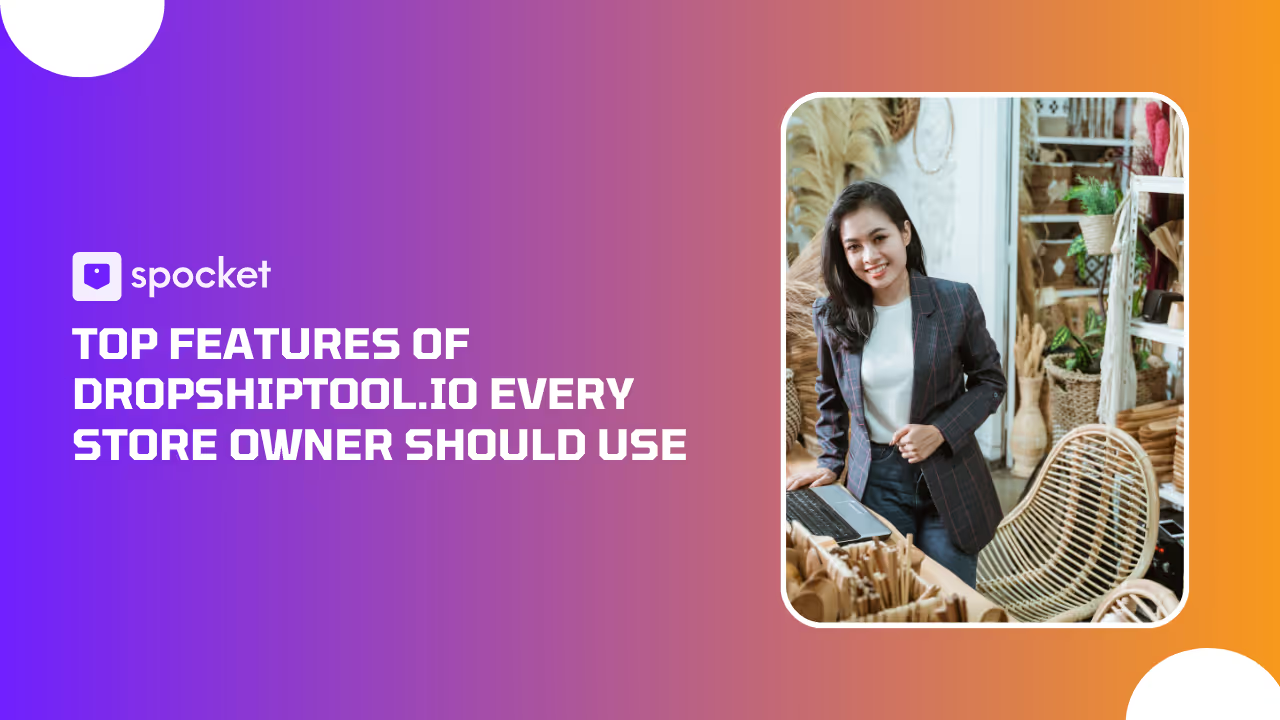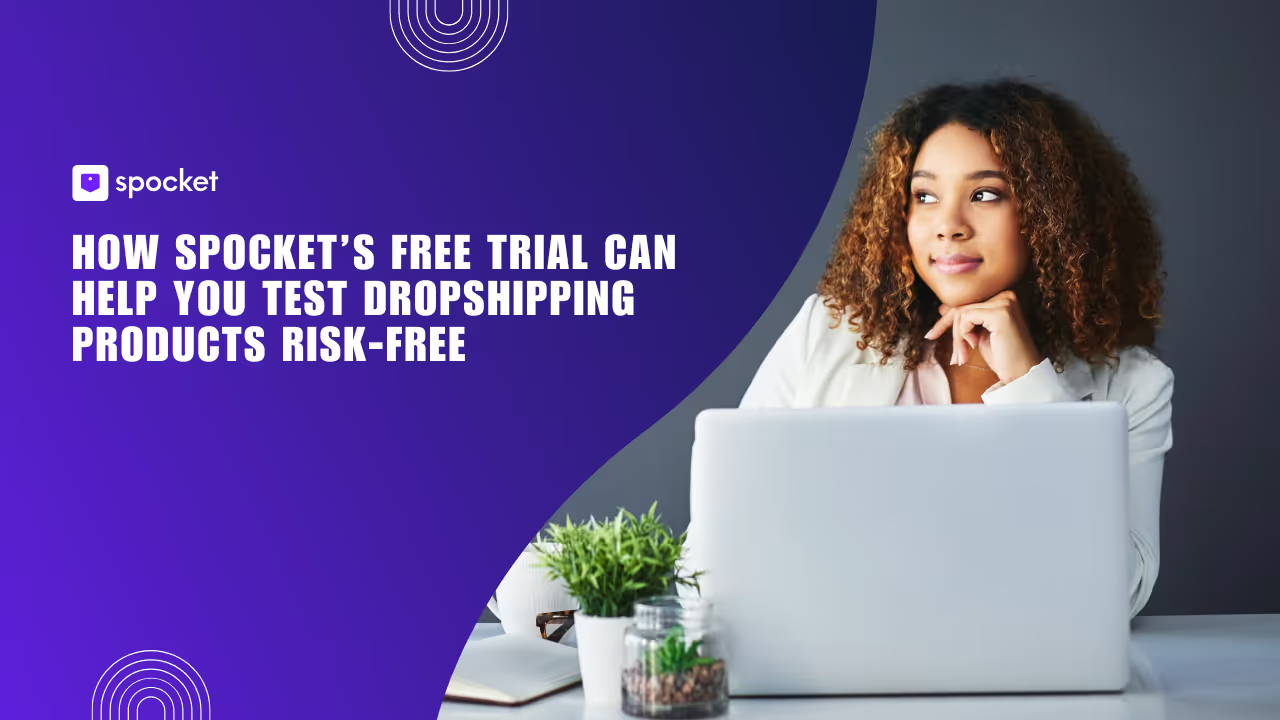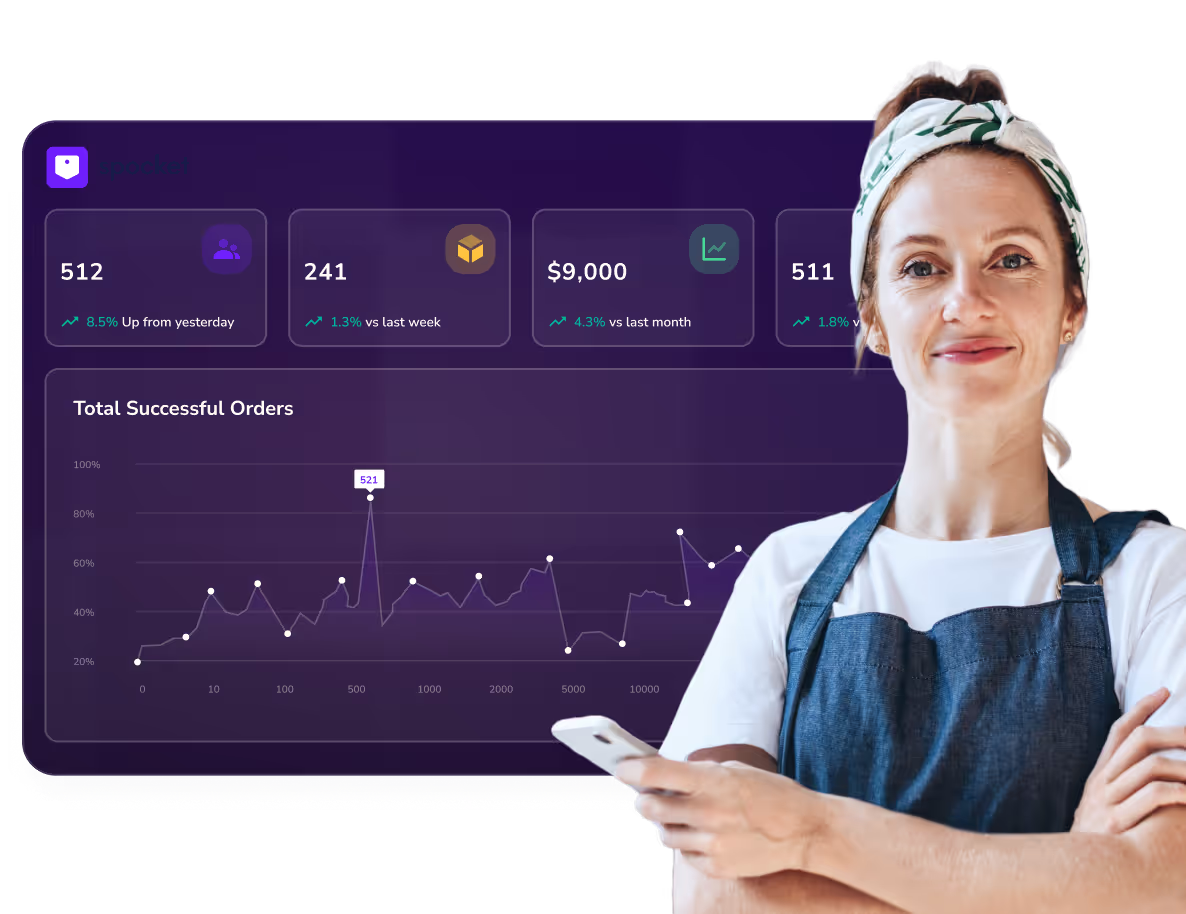Running an online store from India and selling to U.S. customers might sound ambitious, but it’s more achievable than ever. With the right tools and strategy, distance stops being a barrier. That’s exactly what one India-based store discovered when it combined smart marketing with Spocket’s fast U.S. shipping network.
Instead of guessing what products might sell, the team built a simple yet powerful product testing strategy—testing multiple ideas, identifying what clicked with American shoppers, and scaling the winners fast. The result? Shorter delivery times, happier customers, and a brand that felt “local” to people halfway across the world.
This isn’t just another dropshipping story. It’s a roadmap showing how Indian entrepreneurs can tap into the world’s biggest eCommerce market without massive investments or complicated logistics. Let’s break down how it all came together—and how you can replicate the same success.
The Opportunity — Why US Customers Are Worth the Lift
Tapping into the U.S. market isn’t just about chasing higher profits. It’s about understanding what makes American shoppers tick and aligning your business to meet those expectations. Before diving into how an India-based store pulled this off, let’s explore why targeting U.S. customers is such a game-changer.
Understanding the Appeal of the US Market
The U.S. remains the largest consumer market in the world, with millions of online buyers who value convenience, fast delivery, and premium product experiences. For an India-based seller, that means access to a customer base willing to pay for quality—if you can deliver it quickly and reliably.
While many Indian sellers focus only on local marketplaces, those who look west unlock better margins, consistent demand, and exposure to trends that shape global eCommerce. It’s not about luck; it’s about positioning your store where the buying power already exists.
The Real Edge for Indian Entrepreneurs
Here’s the secret: Indian entrepreneurs have a natural advantage. The cost of operations is lower, creativity runs high, and adaptability is built into the hustle. Combine that with a platform like Spocket—where you can connect to U.S.-based suppliers—and you instantly level the playing field.
No need to handle inventory or worry about delayed deliveries. You can operate your store from anywhere in India while your customers in New York or Los Angeles receive their orders in just a few days. It’s the kind of setup that turns a small business into a truly global one.
Why Timing Matters
The timing couldn’t be better. U.S. consumers are increasingly open to discovering international brands—as long as their experience feels local. Fast shipping, clear return policies, and high-quality packaging make that possible.
That’s where our India-based store found its sweet spot. By bridging the gap between affordability and reliability, they built a system that earned trust and repeat sales from American customers who never guessed the business was run thousands of miles away.
The Case Study — Inside “IndiGlow Home”
Every successful business story begins with an experiment. IndiGlow Home, a small startup from Pune, India, didn’t set out to be a global brand overnight. What they did differently was approach U.S. eCommerce with curiosity, data, and patience. This section breaks down how their journey unfolded—step by step.
The Starting Point and the Goal
IndiGlow Home began with a simple idea: create a U.S.-facing online store that sold high-quality home fragrance products—candles, diffusers, and wax melts. Their entire team consisted of just three people handling marketing, operations, and supplier relations.
Their goal was clear: test ten products within the first two months, identify three bestsellers, and hit 200 U.S. orders in the first 60 days. Instead of focusing on volume, they focused on validation—finding what American customers actually wanted.
Building the Stack That Made It Possible
They chose Shopify for store management, Spocket for supplier integration, and Klaviyo for emails. Postscript handled SMS campaigns, while Google Analytics tracked conversions. Every tool served a specific purpose: automate tasks, collect insights, and scale without chaos.
Spocket became the bridge that connected their Indian base with U.S. suppliers. The team used Spocket’s supplier filters to find vendors with U.S. warehouses, quick processing times, and branded invoicing options. Within a few hours, they had a reliable list of partners ready to ship.
How They Tested and Iterated
Instead of launching everything at once, IndiGlow Home ran small tests. They ordered samples from each supplier to inspect product quality, scent strength, packaging, and labeling. Then they launched limited ads—each promoting just one product variation—to see which ones resonated with U.S. buyers.
Within three weeks, three products stood out: a lavender diffuser, a citrus-scented soy candle, and a minimalist wooden holder set. These products had the highest add-to-cart rates and the lowest refund requests, signaling a strong product-market fit.
The Numbers That Told the Story
By week eight, the data spoke for itself.
- Median delivery time: 3.6 days
- Conversion rate: increased from 2.3% to 3.1%
- Average order value: rose from $38 to $44
- Customer acquisition cost: dropped from $19 to $14
- Return rate: only 2.8%
The best part? Over 40% of buyers came back for a repeat purchase within 45 days. IndiGlow didn’t just find winning products—they found loyal customers.
The Real Takeaway
IndiGlow Home’s journey wasn’t about luck. It was about running smart experiments, tracking results, and using platforms like Spocket to eliminate logistical friction. They focused on what they could control—great products, fast delivery, and a personal brand experience—and let the tools handle the rest.
This mindset shift turned a small Indian store into a cross-border success story.
Setting Up Spocket for US Delivery — The Exact Workflow
Before scaling, IndiGlow Home had to get one thing right—fulfillment. If the delivery experience failed, no amount of good marketing could save the business. This section breaks down how they used Spocket to create a smooth, reliable delivery pipeline for U.S. customers.
Sourcing Filters That Actually Matter
When you’re targeting U.S. customers, speed and reliability come first. On Spocket, IndiGlow applied strict filters:
- Supplier country set to the United States
- Processing time within one business day
- Shipping window between two to five days
- Seller rating of 4.5 or higher
- Branded invoicing enabled
These filters instantly narrowed down thousands of suppliers to a handful of dependable partners. By prioritizing suppliers who already stocked inventory in the U.S., they avoided the long shipping delays that often kill customer trust.
Sampling Before Scaling
Instead of relying on supplier photos or promises, IndiGlow ordered product samples. This step saved them countless future headaches. Each sample was inspected for quality, packaging, scent consistency, and even label placement.
They noticed that one supplier’s product looked great online but arrived poorly packed. That supplier was immediately removed from the list. By doing this small test, they ensured only top-quality suppliers made the cut—protecting both the brand’s reputation and the customer experience.
Automations That Simplified Everything
Once the suppliers were finalized, IndiGlow automated as much as possible. Spocket’s auto-fulfillment feature ensured that every new order went directly to the correct supplier, without any manual intervention. Inventory sync prevented overselling, and pricing multipliers maintained consistent profit margins across the catalog.
They also activated branded invoicing, which meant each package arrived with IndiGlow’s logo and messaging instead of the supplier’s. This small detail helped the brand look professional and trustworthy—key factors when selling to U.S. buyers who value brand identity.
Why This Workflow Worked
This wasn’t about luck or shortcuts—it was about process. Spocket acted as their U.S. logistics arm while the IndiGlow team focused on marketing, customer engagement, and creative growth. The result? A system that delivered products quickly, minimized errors, and built customer trust from day one.
Store & Ops Built for US Buyers
Getting the logistics right was only half the battle. IndiGlow Home also needed to design a store experience that felt trustworthy and familiar to U.S. shoppers. This section explores how they built operations and customer-facing systems that matched American expectations.
Payments and Building Trust
One of the first challenges IndiGlow faced was payments. Many international gateways create friction for India-based sellers, especially when accepting U.S. dollars. The team explored options like Stripe Atlas and Payoneer, which allowed them to collect payments seamlessly in USD and transfer funds back home with minimal delays.
They also made transparency a key part of their payment process. Every product page clearly displayed pricing in U.S. dollars, included taxes upfront, and specified shipping timelines. That clarity instantly boosted trust and reduced customer hesitation.
For many American buyers, trust begins long before checkout. Seeing “Ships from the U.S.” and transparent return policies helped them feel confident buying from a brand they had just discovered.
Policies That Reduce Returns
Returns are inevitable, but they don’t have to be painful. IndiGlow Home offered a 30-day hassle-free return policy, backed by their U.S.-based suppliers. Customers could initiate returns directly through a simple form, and suppliers handled replacements or refunds within days.
They also ensured every product listing stated, “Ships within 2–5 business days from U.S. warehouse.” This simple line became one of their most effective trust signals. Shoppers appreciated knowing exactly when to expect their order.
The team added a visual delivery timer on product pages, showing estimated delivery windows by city. It wasn’t just functional—it made the shopping experience feel transparent and personal.
Crafting Product Pages That Convert
Every product description was rewritten with U.S. customers in mind. Instead of generic text, they focused on lifestyle-driven storytelling: “Light this candle after a long day—it’s like a warm hug for your home.” This shift from product features to emotional benefits doubled their add-to-cart rate.
They used high-resolution lifestyle images shot against clean, modern backdrops, reflecting U.S. interior aesthetics. Customer reviews were displayed prominently near the buy button, featuring authentic feedback and real names to add social proof.
Each product page also included quick FAQs about delivery, refunds, and care instructions, removing last-minute doubts that could block conversions.
Why It Worked
IndiGlow Home didn’t just localize logistics—they localized emotion. They spoke to U.S. buyers in a tone and style that felt native, eliminated uncertainty through transparent policies, and ensured that every purchase felt effortless.
The result? A store that delivered not only beautiful products but also a buying experience that made customers come back again and again.
Marketing the US — Creatives, Offers, and Local Timing
Once the store and logistics were in place, IndiGlow Home turned its focus to visibility. Selling great products wasn’t enough—they needed to reach U.S. audiences with the right message, at the right time, and in the right way. Here’s how they approached marketing with precision and authenticity.
Understanding the U.S. Audience
American shoppers don’t just buy products—they buy stories, values, and experiences. IndiGlow’s team quickly learned that their messaging had to shift from “what” they were selling to “why” it mattered.
Instead of promoting candles with standard descriptions, they leaned into emotion. Campaigns carried relatable lines like, “Your home deserves to smell like calm.” The language was simple, the visuals were warm, and the products were always positioned as part of a lifestyle, not just an item for sale.
Crafting Offers That Convert
IndiGlow tested multiple offers before landing on a few that consistently worked. Free shipping above $50, limited-edition scents, and bundle discounts all increased conversions. But the biggest winner was a “Buy two, get one 50% off” deal that boosted both average order value and repeat purchases.
They also experimented with time-sensitive offers, such as weekend flash sales, to trigger urgency. Each promotion was paired with clean, minimal creatives and strong calls to action. The focus was never on aggressive selling—it was on making the buying decision feel easy and rewarding.
Ad Creative and Copy Testing
To find what resonated, IndiGlow used short video ads showing candles being lit, diffusers releasing fragrance, and cozy home scenes. These visuals instantly connected with the target audience—young adults and homeowners seeking comfort and calm.
They tested multiple ad angles at once, analyzing engagement, click-through rates, and conversions. Simple, emotion-driven captions like “Breathe. Relax. Repeat.” outperformed product-heavy descriptions every time.
Timing the Campaigns Right
Running ads from India meant navigating a 9–12 hour time difference. To overcome that, IndiGlow scheduled their campaigns to match peak U.S. activity hours—typically 6–10 PM Eastern and 7–9 AM Pacific.
Email and SMS campaigns were sent during U.S. mornings when users were most active. This small adjustment improved open rates and conversions significantly. Even social media posts were timed for American weekends, aligning with shopping peaks.
Why This Strategy Worked
IndiGlow didn’t rely on one big marketing push. They built consistency—showing up daily in customers’ feeds, inboxes, and search results with relevant, human messaging. By understanding cultural context and adjusting their tone, visuals, and timing, they managed to feel local even from across the world.
In short, their marketing wasn’t about shouting louder—it was about speaking smarter.
Conclusion — From First 50 Orders to Sustainable Scale
Breaking into the U.S. market from India isn’t about having huge capital or complicated logistics—it’s about building smart systems, testing constantly, and understanding what customers truly value. IndiGlow Home proved that with the right mix of tools, focus, and adaptability, borders don’t have to limit ambition.
Their success came from clarity, not luck. They knew which products to test, how to deliver quickly through Spocket, and how to make U.S. buyers feel connected to a brand that was built thousands of miles away. Each decision—from supplier filters to ad timing—was data-backed and intentional.
The takeaway is simple: success in global eCommerce comes down to trust, speed, and customer experience. When those three align, your business stops being “India-based” and starts being global. All you need is a strategy that blends efficiency with empathy—and the courage to start.




















































